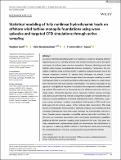| dc.contributor.author | Guth, Stephen | |
| dc.contributor.author | Katsidoniotaki, Eirini | |
| dc.contributor.author | Sapsis, Themistoklis P. | |
| dc.date.accessioned | 2024-04-18T16:40:00Z | |
| dc.date.available | 2024-04-18T16:40:00Z | |
| dc.date.issued | 2023-11-14 | |
| dc.identifier.issn | 1095-4244 | |
| dc.identifier.issn | 1099-1824 | |
| dc.identifier.uri | https://hdl.handle.net/1721.1/154213 | |
| dc.description.abstract | Accurately determining hydrodynamic force statistics is crucial for designing offshore engineering structures, including offshore wind turbine foundations, due to the significant impact of nonlinear wave–structure interactions. However, obtaining precise load statistics often involves computationally intensive simulations. Furthermore, the estimation of statistics using current practices is subject to ongoing discussion due to the inherent uncertainty involved. To address these challenges, we present a novel machine learning framework that leverages data‐driven surrogate modeling to predict hydrodynamic loads on monopile foundations while reducing reliance on costly simulations and facilitate the load statistics reconstruction. The primary advantage of our approach is the significant reduction in evaluation time compared to traditional modeling methods. The novelty of our framework lies in its efficient construction of the surrogate model, utilizing the Gaussian process regression machine learning technique and a Bayesian active learning method to sequentially sample wave episodes that contribute to accurate predictions of extreme hydrodynamic forces. Additionally, a spectrum transfer technique combines computational fluid dynamics (CFD) results from both quiescent and extreme waves, further reducing data requirements. This study focuses on reducing the dimensionality of stochastic irregular wave episodes and their associated hydrodynamic force time series. Although the dimensionality reduction is linear, Gaussian process regression successfully captures high‐order correlations. Furthermore, our framework incorporates built‐in uncertainty quantification capabilities, facilitating efficient parameter sampling using traditional CFD tools. This paper provides comprehensive implementation details and demonstrates the effectiveness of our approach in delivering reliable statistics for hydrodynamic loads while overcoming the computational cost constraints associated with classical modeling methods. | en_US |
| dc.language.iso | en | |
| dc.publisher | Wiley | en_US |
| dc.relation.isversionof | 10.1002/we.2880 | en_US |
| dc.rights | Creative Commons Attribution | en_US |
| dc.rights.uri | https://creativecommons.org/licenses/by/4.0/ | en_US |
| dc.source | Wiley | en_US |
| dc.subject | Renewable Energy, Sustainability and the Environment | en_US |
| dc.title | Statistical modeling of fully nonlinear hydrodynamic loads on offshore wind turbine monopile foundations using wave episodes and targeted CFD simulations through active sampling | en_US |
| dc.type | Article | en_US |
| dc.identifier.citation | Guth S, Katsidoniotaki E, Sapsis TP. Statistical modeling of fully nonlinear hydrodynamic loads on offshore wind turbine monopile foundations using wave episodes and targeted CFD simulations through active sampling. Wind Energy. 2024; 27(1): 75-100. | en_US |
| dc.contributor.department | Massachusetts Institute of Technology. Department of Mechanical Engineering | |
| dc.relation.journal | Wind Energy | en_US |
| dc.eprint.version | Final published version | en_US |
| dc.type.uri | http://purl.org/eprint/type/JournalArticle | en_US |
| eprint.status | http://purl.org/eprint/status/PeerReviewed | en_US |
| dc.date.updated | 2024-04-18T14:12:22Z | |
| dspace.orderedauthors | Guth, S; Katsidoniotaki, E; Sapsis, TP | en_US |
| dspace.date.submission | 2024-04-18T14:12:26Z | |
| mit.journal.volume | 27 | en_US |
| mit.journal.issue | 1 | en_US |
| mit.license | PUBLISHER_CC | |
| mit.metadata.status | Authority Work and Publication Information Needed | en_US |
